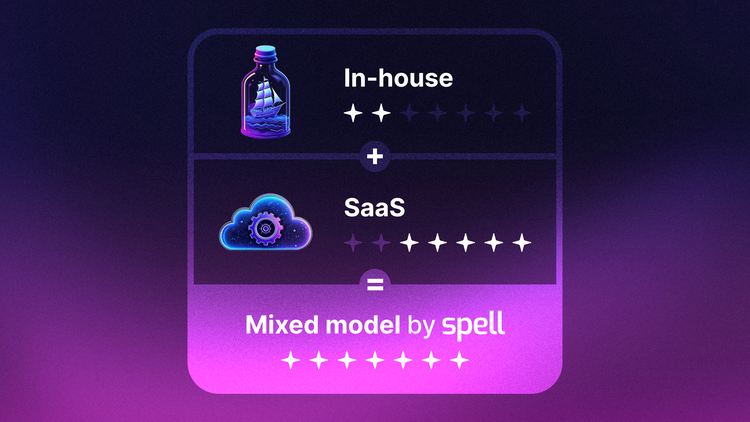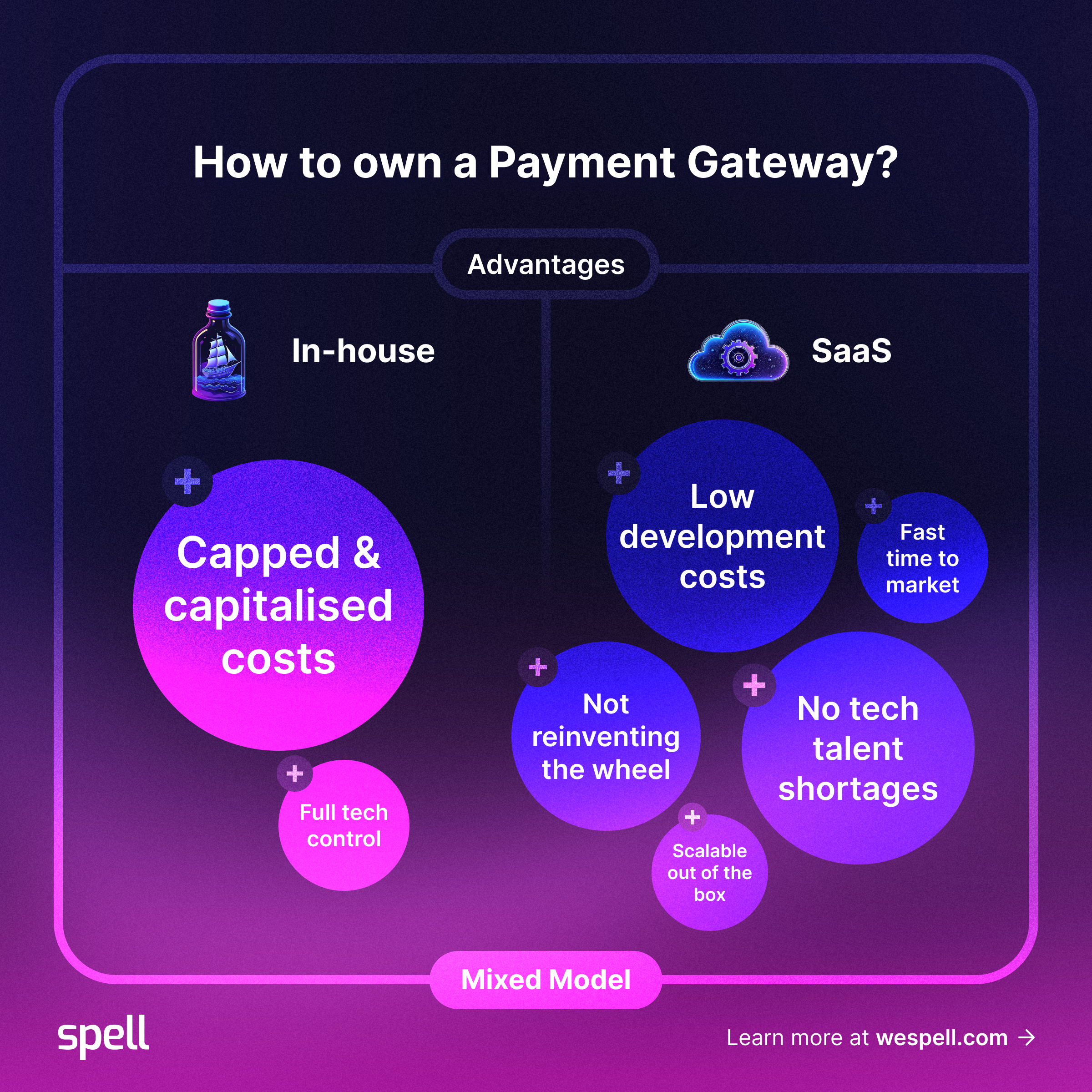Executive’s Guide: Tech to Win in the Payment Business
Download our guide for executives who are launching or scaling payment infrastructure in 2025.

Deciding between building an in-house payment gateway or using a white-label SaaS solution can be pivotal for businesses looking to launch their payment processing services or layer.
This decision is especially important for small to mid-sized companies entering the payment gateway market, aiming to offer professional solutions like those in the Forbes best payment gateways list without having the resources of industry giants.
At Spell, we empower businesses to start or upgrade their payments businesses by using a platform designed to optimize and scale them.

There are only two advantages to having an in-house payment gateway.
Control of the tech stack, source code, and, consequently, all the intellectual property (IP) related to the whole system and the choices made developing it.
You are gaining a capitalized asset on your balance sheet. Still, this is true only if the tech is well done and liquid.
Building an in-house payment gateway offers full control over the tech stack, development team, and features. However, this approach is accessible only to large businesses with high-tech expertise, ample resources, and specific professional needs, as it comes with multiple challenges. Is it worth the strategic advantage? Let’s explore.
While the control and customization of in-house payment gateways are appealing, they come with substantial costs, time commitments, and operational risks.
Building an in-house payment gateway involves significant expenses across multiple areas. You must invest heavily in developing the software and infrastructure, including server capacity, integration capabilities, and security measures.
White-label payment gateways eliminate the need for large upfront investments by providing a fully built, ready-to-use platform with pre-integrated infrastructure, security, and compliance features. This allows you to avoid the financial burden of developing and maintaining software, servers, and security measures from scratch.
Building a payment gateway demands a highly skilled team with expertise in software development, security, and regulatory compliance. Finding and hiring the right professionals for these specialized roles can be challenging, as the market for such talent is highly competitive.
White-label solutions like Spell come with a team of experts who handle the development, security, and compliance aspects for you, eliminating the need to hire and manage specialized talent. This allows your business to benefit from expert knowledge without the costs and challenges of sourcing and retaining a highly skilled workforce.
Developing an in-house payment gateway can be a long and complex process, often taking year/-s to go live on the market. This lengthy timeline can be a major disadvantage in a fast-moving market, where delays in launching a payment solution could result in lost opportunities and falling behind competitors.
In contrast, white-label SaaS solutions provide a much faster path to market, allowing businesses to launch their branded gateway in just days or weeks. This rapid deployment helps companies remain agile, seizing market opportunities and staying competitive without sacrificing quality or functionality.
Many of the core technologies that power payment gateways have already been refined and perfected by industry experts over years of development. Attempting to recreate these complex systems from scratch can introduce unnecessary challenges, from navigating technical hurdles to addressing security vulnerabilities.
Leveraging existing, well-established solutions helps avoid these complications, ensuring businesses can offer reliable and secure services without the risks and expenses of starting from the ground up. White-label payment gateways leverage industry-tested technologies, allowing you to bypass the complexities of developing these systems from scratch.
Scaling an in-house payment gateway involves ongoing demands for constant upgrades to both infrastructure and security measures. As transaction volumes grow, businesses must invest in additional features defined and built in the right sequence to minimize the operating noise, server capacity, enhanced data storage solutions, and increased bandwidth to ensure optimal performance.
White-label payment gateways are designed to scale effortlessly as your business grows, with built-in infrastructure that automatically adjusts to increased transaction volumes. This means you can expand without worrying about costly upgrades to servers, storage, or security, as the platform handles these scaling needs for you in a seamless and efficient way.
SaaS payment gateways serve as a natural solution to the disadvantages of an in-house system.
However, while SaaS payment gateways address most of the drawbacks of in-house solutions, offering flexibility, rapid deployment, and lower initial costs, there are two potential downsides:
For growing companies, a mixed model can resolve these issues by combining the best of both worlds: the control and customization of an in-house solution with the scalability and convenience of SaaS platforms.
At Spell, we understand that some businesses may want to maintain some control over their payment systems while also benefiting from the cost-efficiency of SaaS. That’s why we offer a mixed model.
With our mixed approach, you can start with our white-label SaaS solution, which all the top-notch features necessary to get the best results in a payments business already has built-in, with an opportunity to create valuable addons or gradually transition some functions in-house, as your business grows. That's how you’ll have all the benefits of owning the IP and source code of specific components you choose to develop while not reinventing the wheel, using your resources wisely, and relying on our infrastructure for the core engine of the gateway.
This model allows you to expand and customize as needed without losing the flexibility of SaaS. We’re here to help you scale smoothly, whether you’re a smaller business looking for a fast-to-market solution or a large enterprise considering a more custom, long-term strategy.
For most businesses, the time, cost, and complexity of building an in-house payment gateway simply aren’t justifiable. White-label SaaS solutions like Spell offer a more practical and scalable option, enabling you to quickly launch a branded gateway with full compliance, security, and scalability already built in.
However, for businesses with specific needs or large-scale operations, Spell’s mixed model offers the flexibility to transition to partial or full in-house control over time. This gives you the best of both worlds—cost-effective SaaS today, with the option to evolve into a more customized solution as your business grows.
With Spell, you can jumpstart or upgrade your payment business in 1 week, sometimes as quickly as 1 day, to get you winning in the hyper-competitive payments industry.
Spell platform is built on a robust AWS infrastructure, with an outstanding 99.999% uptime, and is PCI DSS Level 1 compliant, as Visa confirms.
We offer various standard features, such as different integration options, SDKs, and plugins, as well as billing, links for marketing campaigns, payment orchestration tools, digital onboarding, real-time account balances, and many other value-added tools to scale and optimize your payments business.
Take a Demo Tour to talk to Sales and accelerate your business with the best white label payment platform on the market!
Let’s get Spelling!
#spelltosell
Download our guide for executives who are launching or scaling payment infrastructure in 2025.
Discover features that are crucial to be competitive and successful in the payments business for 2025 and beyond.